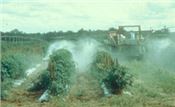EPA Proposes An Update To The WPS Application Exclusion Zone Regulations

Figure 1. Proposed changes will simplify AEZ requirements.
Photo: Ric Bessin, UK
DR. RIC BESSIN
LEXINGTON, KY.
The EPA has proposed changes to the Worker Protection Standard (WPS) pesticide Application Exclusion Zone (AEZ) requirements. The changes would improve enforcement and simplify requirements for pesticide applicators on farms in complying with AEZ regulations. The Application Exclusion Zone requirement, as part of the WPS, is intended to safeguard agricultural workers and other on-farm persons from pesticide exposure.
The EPA is proposing the following changes:
• Modify the AEZ so it is applicable and enforceable only on a farm owner’s property, where a farm owner can lawfully exercise control over employees and bystanders who could fall within the AEZ. As currently written, the off-farm aspect of this provision has proven very difficult for state regulators to enforce. These proposed changes would enhance both enforcement and implementation of the AEZ for state regulators and farm owners, respectively. Off-farm bystanders would still be protected from pesticide applications thanks to the existing “do not contact” requirement that prohibits use in a manner that would contact unprotected individuals.
• Exempt immediate family members of farm owners from all aspects of the AEZ requirement. This will allow farm owners and their immediate family members to decide whether to stay in their homes or other enclosed structures on their property during certain pesticide applications, rather than compelling them to leave even when they feel safe remaining.
• Add clarifying language that pesticide applications that are suspended due to individuals entering an AEZ may be resumed after those individuals have left the AEZ.
• Simplify the criteria for deciding whether pesticide applications are subject to the 25- or 100-foot AEZ. The AEZ is the area surrounding pesticide application equipment that exists only during outdoor production pesticide applications. The AEZ will remain 25-feet in all directions for ground pesticide applications, and 100-feet in all directions for outdoor aerial, air blast, air-propelled, fumigant, smoke, mist and fog pesticide applications.
As part of the process to update these regulations, the EPA will open a 90-day comment period once the proposal is published in the Federal Register in order to solicit input on these proposed changes. ∆
DR. RIC BESSIN: Extension Entomologist, University of Kentucky